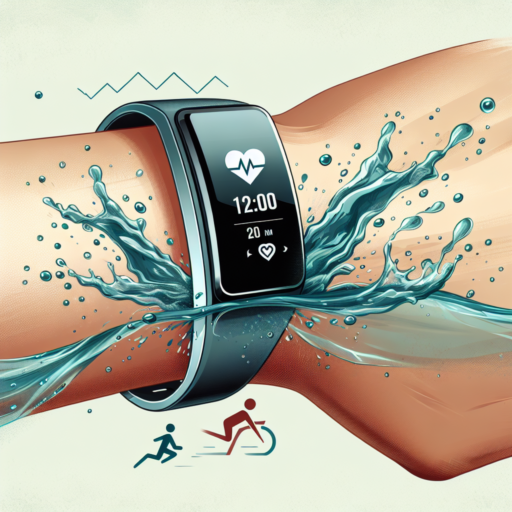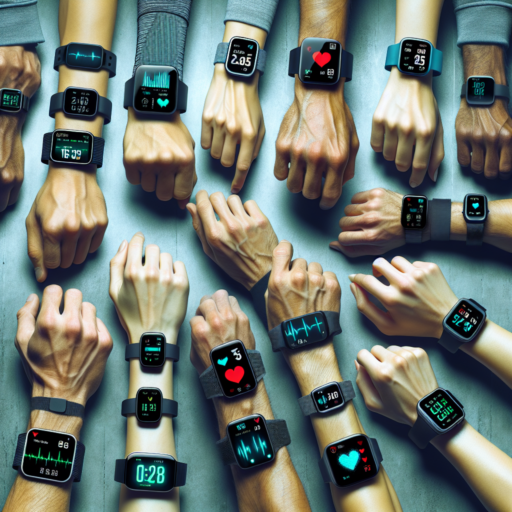Overview of Water Resistant Heart Rate Monitors
In the realm of fitness and health tracking, water resistant heart rate monitors have emerged as a pivotal tool for athletes and fitness enthusiasts alike. These devices enable users to accurately track their heart rate while engaging in water-based activities, such as swimming or water aerobics, without worrying about water damage. The evolution of this technology has led to a wide range of features and options, catering to various needs and preferences.
Design and Functionality are critical aspects that differentiate these monitors. Typically, manufacturers focus on creating designs that are not only waterproof but also sleek and comfortable to wear for extended periods. This involves using materials that can withstand the rigors of water pressure and chemicals such as chlorine. Functionality-wise, modern water-resistant heart rate monitors come equipped with advanced sensors that can provide accurate heart rate readings, even in aquatic environments. This has been a game-changer for swimmers and triathletes who rely on heart rate data to optimize their training.
Furthermore, the integration of smart technology has enhanced the utility of these monitors significantly. Many models now offer connectivity with smartphones and fitness apps, allowing users to track their performance, set goals, and monitor progress over time. This connectivity is not just limited to dry land activities; it extends to water sports, providing a seamless and interconnected fitness tracking experience.
Benefits of Using a Water Resistant Heart Rate Monitor
When it comes to optimizing your workout routines, understanding your heart rate is crucial. A water resistant heart rate monitor can be a game-changer, especially for athletes and fitness enthusiasts who incorporate water activities into their regimen. This innovative technology ensures reliable heart rate data collection, without letting water interfere.
Durability and Versatility
The primary benefit of a water resistant heart rate monitor lies in its durability. Designed to withstand not just splashes, but also complete immersion, these devices can accompany you during rigorous swimming sessions, triathlons, or rainy outdoor activities. The versatility of these monitors makes them a worthy investment for those passionate about maintaining their fitness levels, regardless of the weather conditions or the nature of their workout.
Accurate Heart Rate Tracking in All Conditions
Accuracy is pivotal in heart rate monitoring, and water resistant heart rate monitors are engineered to deliver precise readings in wet conditions. Traditional monitors may falter when exposed to water, leading to unreliable data. However, water resistant models ensure that your heart rate is accurately tracked whether you’re sweating it out in a gym or taking a dive in the pool. This consistent accuracy helps in effectively gauging workout intensity and making necessary adjustments for optimal performance and health outcomes.
Top Water Resistant Heart Rate Monitors in 2023
In 2023, staying on top of your fitness game requires equipment that can withstand more than just a sweaty workout. Among the essentials, water resistant heart rate monitors have become a staple for athletes and fitness enthusiasts who like to push their limits, not only on land but also in water. This article highlights the most proficient and innovative water resistant heart rate monitors that have made a significant impact this year.
Garmin HRM-Swim
The Garmin HRM-Swim stands out as a frontrunner in water resistant heart rate monitors. Designed specifically for swimmers, it boasts a non-slip strap and a compact form factor that resists water pressure, making it ideal for pool sessions and open-water swims. Its advanced technology allows it to store heart rate data underwater and transfer it to your connected devices post-workout, ensuring accurate performance analysis.
Polar H10
Renowned for its precision, the Polar H10 offers versatility and durability for a wide range of sports and exercise activities, including swimming. With its enhanced waterproof design, it can be submerged up to 30 meters, making it not only great for swimming but also perfect for high-intensity water sports. The precision of the Polar H10’s heart rate monitoring is complemented by its compatibility with a myriad of fitness apps, giving you the flexibility to tailor your training and analysis.
Wahoo TICKR X
The Wahoo TICKR X is recognized for its dual-band technology, allowing connectivity to both Bluetooth and ANT+ devices. This water resistant heart rate monitor excels with its internal memory feature, capable of storing over 50 hours of workout data. Perfect for swimmers who prefer to leave their phones behind, the TICKR X syncs seamlessly with your devices post-swim to provide detailed insights into your performance. Furthermore, its water resistance makes it suitable for all weather conditions, ensuring reliable data regardless of your training environment.
How to Choose the Best Water Resistant Heart Rate Monitor for Your Needs
When selecting the best water resistant heart rate monitor to match your specific requirements, it’s essential to consider several crucial factors. With the myriad options available on the market, identifying the perfect device for your fitness or health needs can be overwhelming. This guide will navigate through key considerations to ensure you make a well-informed decision.
First, assess the degree of water resistance you need. Not all heart rate monitors offer the same level of protection against water. While some are merely splash-proof, suitable for running in the rain, others are fully waterproof, designed for swimmers and triathletes. Check the device’s IP rating—a measure of its resistance to dust and water—to ensure it matches your intended activities.
Another vital factor is the accuracy of the heart rate data. For athletes and fitness enthusiasts, precision in monitoring heart rate is crucial for effective training and recovery. Look for monitors that offer continuous, real-time heart rate tracking with minimal lag. Additionally, consider devices that include features such as heart rate zones and alerts to optimize your workouts by staying in the desired heart rate range.
Lastly, consider the compatibility and connectivity of the heart rate monitor with your existing devices and fitness applications. A device that seamlessly syncs with your smartphone, smartwatch, or fitness apps can greatly enhance your tracking and analysis capabilities. Ensure the monitor supports the connectivity options you require, such as Bluetooth or ANT+, to facilitate easy integration with your current setup.
Comparing Prices: Water Resistant Heart Rate Monitors
When delving into the world of fitness technology, especially water-resistant heart rate monitors, price comparison is an invaluable step to ensuring you find the perfect match for your needs and budget. These devices offer the unique combination of heart rate tracking with the durability to withstand moisture, making them ideal for swimmers, triathletes, or anyone who enjoys a rigorous, sweat-inducing workout.
Factors Influencing Price
Several factors can influence the price of water-resistant heart rate monitors. Brand reputation and additional features, such as Bluetooth connectivity, GPS, and long battery life, play significant roles. Monitors that provide detailed analytics and syncing capabilities with other devices tend to be pricier. However, these additional features can greatly enhance your training effectiveness, making them worth the extra cost for serious athletes.
Price Range Expectations
The price range for water-resistant heart rate monitors can vary significantly. Basic models that offer simple heart rate monitoring with water resistance are available at more affordable prices. These are ideal for beginners or those who require minimal data for their workouts. On the other end of the spectrum, advanced models come with a hefty price tag but provide a comprehensive suite of features including detailed heart rate zones, recovery time suggestions, and even swim stroke detection.
Understanding the various price points and the features associated with each can help you make an informed decision when selecting a water-resistant heart was monitor that meets your fitness needs and budget constraints. Whether you are a seasoned athlete or a fitness enthusiast looking to level up your training, comparing prices and features is a crucial step in the selection process.
Setting Up Your Water Resistant Heart Rate Monitor for Optimal Performance
Getting the most out of your water resistant heart rate monitor involves more than just strapping it on. It requires a careful setup to ensure accuracy, comfort, and durability. Whether you’re a seasoned athlete or a fitness enthusiast, understanding the correct setup process can significantly impact your training efficiency and overall performance.
Initial Configuration
Begin with the initial configuration of your device. Most models require you to input personal information such as age, weight, and height. This data is crucial for accurate heart rate calculations, as it helps the device tailor its readings to your specific physiological characteristics. Make sure to navigate through the settings menu to find where to input this essential information.
Adjusting the Strap for Comfort and Accuracy
The fit of your heart rate monitor strap is pivotal for both comfort and accurate readings. A strap that’s too tight can restrict blood flow, while one that’s too loose may lead to inconsistent readings. Adjust the strap so it sits snugly below the chest muscle. For water-resistant models, ensure the strap and the monitor are thoroughly clean and dry before wearing them to improve the conductivity and the overall accuracy of heart rate monitoring.
Software Updates and Calibration
Keeping your device updated is key to maintaining optimal performance. Manufacturers frequently release software updates that can improve accuracy, introduce new features, or fix known issues. Connect your heart rate monitor to the manufacturer’s app or website regularly to check for and install any updates. Additionally, if your device offers calibration options, use them. Calibration can fine-tune the device’s accuracy, ensuring that the heart rate readings you rely on during your workouts are as precise as possible.
No se han encontrado productos.
Maintenance Tips for Your Water Resistant Heart Rate Monitor
Keeping your water resistant heart rate monitor in top condition ensures it continues to provide accurate data and withstand the rigors of your most intense workouts. Regular maintenance is essential for prolonging its lifespan and optimizing its performance. Below, we share some crucial maintenance tips to help you care for your device properly.
Keep It Clean
Cleanliness is paramount for maintaining the integrity of your heart rate monitor. After each use, gently wipe the device with a soft, damp cloth to remove sweat, dirt, and any residue. For the strap, if it’s removable and washable, rinse it with mild soap and water. Allow the strap to air dry completely before reattaching it to the monitor. Avoid using abrasive cleaners or solvents that could damage the device’s coating and seals.
Check for Wear and Tear
Regularly inspect your heart rate monitor for signs of wear and tear. Check the strap for any fraying, stretch, or breaks in the material. Monitor the casing and seals for any cracks or damages that could compromise its water resistance. Addressing these issues promptly can prevent further damage and ensure your device remains effective and accurate during your training sessions.
Battery Care
For heart rate monitors with a user-replaceable battery, it’s crucial to monitor the battery life and replace it as necessary. Always follow the manufacturer’s instructions for battery replacement to avoid damaging the water-resistant seal. For devices with rechargeable batteries, avoid overcharging, which can shorten battery life. Instead, charge your device according to the manufacturer’s recommendations to ensure optimal battery health and performance.
Understanding the Technology Behind Water Resistant Heart Rate Monitors
The surge in popularity of water-resistant heart rate monitors has revolutionized how athletes and fitness enthusiasts track their performance in environments prone to moisture. At the core of these advanced devices, innovative technology works seamlessly to ensure accurate data collection, regardless of the challenges presented by water exposure. This exploration into the technology behind these vital pieces of fitness equipment uncovers the meticulous design and engineering that make them indispensable to modern training routines.
Sealing Techniques and Materials
The first line of defense in water-resistant heart rate monitors is the selection of materials and sealing methods used in their construction. Manufacturers often employ silicone seals and gaskets, known for their water-repelling properties and flexibility, ensuring a tight closure. The casing itself is typically made from polymer composites that offer superior durability and resistance to water penetration, safeguarding the sensitive electronics housed within. These materials work together to prevent water ingress, maintaining the functionality of the heart rate monitor in wet conditions.
Advanced Sensor Technology
At the heart of these devices lies sophisticated sensor technology designed to perform in aquatic environments. The key component is an optical heart rate sensor, which utilizes LED lights to penetrate the skin and detect blood volume changes. This method, known for its precision, remains effective underwater, providing reliable data without direct skin contact. Additionally, accelerometer-based motion detection complements the heart rate data, offering insights into the wearer’s activity level, even during vigorous swimming strokes.
Real User Reviews: The Best Water Resistant Heart Rate Monitors on the Market
When it comes to maintaining an active lifestyle, understanding and tracking your heart rate is crucial. For swimmers, runners in the rain, or anyone engaging in water sports, finding a water resistant heart rate monitor that can keep up with your activities is essential. Real user reviews play a vital role in determining which devices stand out in the flooded market of fitness trackers.
Consumers have praised the durability and accuracy of several models, highlighting features such as long battery life, comfortable wear, and, importantly, the ability to track heart rate accurately while being submerged. These devices not only cater to swimmers but anyone looking for a reliable heart rate monitor that can endure conditions where other monitors might falter.
Interestingly, feedback often touches on how these heart rate monitors have become an integral part of users’ fitness routines, providing insights into cardiovascular health, helping to improve overall fitness strategies, and even motivating users by tracking their progress and achievements. It’s clear from user testimonials that the best water resistant heart rate monitors combine functionality with durability, offering features that go beyond just monitoring heart rate, including tracking various types of workouts and offering connectivity with other devices.
FAQs: Everything You Need to Know About Water Resistant Heart Rate Monitors
In the realm of fitness technology, water-resistant heart rate monitors have surged in popularity, catering to swimmers, triathletes, and everyday fitness enthusiasts who demand performance in wet conditions. This rise in popularity inevitably brings forth a plethora of questions about their capabilities, limitations, and functionalities. Below, we explore some of the most pressing FAQs to provide a clearer understanding of these innovative devices.
What Makes a Heart Rate Monitor Water-Resistant?
Water resistance in heart rate monitors is primarily achieved through meticulous design and manufacturing processes that prevent water from penetrating the device’s internal components. These devices are typically sealed with gaskets or O-rings and use materials that repel water. It’s important to note the difference between water-resistant and waterproof ratings, often denoted by IPX or ATM standards, which indicate how well a device can withstand immersion and at what depth.
Can Water-Resistant Heart Rate Monitors Measure Heart Rate Accurately In Water?
One common question revolves around the accuracy of heart rate measurements in water. Technological advancements have enabled these devices to provide remarkably accurate readings, even when submerged. However, the accuracy can vary based on the technology used—optical (PPG) sensors versus chest straps with electrical sensors. While optical sensors work well for many activities, they may face challenges with water interference; whereas, chest straps, which detect electrical signals directly from the heart, tend to offer more reliable readings under water.
Compatibility with Swimming Strokes
Moreover, the design and snugness of the device play pivotal roles in ensuring accuracy during various swimming strokes. A heart rate monitor that securely fits, preventing water from flowing between the device and the skin, will likely offer more consistent data. This snug fit is crucial during vigorous activities like freestyle or butterfly strokes, where excessive movement can disrupt the monitor’s ability to maintain constant contact with the skin.
In conclusion, water-resistant heart rate monitors have transformed how athletes and fitness enthusiasts track their heart rates in aquatic environments. Understanding their design, functionality, and proper usage can significantly enhance one’s training regime, allowing for an informed approach to improving cardiovascular fitness.




